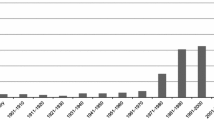Abstract
Any field of scientific knowledge undergoes maintenance and evolution. This is accomplished in a variety of ways, but especially through the training of researchers who will dedicate their scientific careers to the area of science in which they were trained. Forming this type of researcher is a process that is subordinated to the sets of rules and values of each academic community. In a simplified way, this process can be understood as one that transforms a student into a researcher who, in turn, will take on the task of forming new researchers. Thus, the academic supervision that transforms a student into a new researcher occupies a central role in the development of each field of science, and can help explain the characteristics of that field. This work examines how the field of academic research in freshwater fish farming has unfolded in Brazil. This is accomplished by making use of the links between advisor and advisee to describe the involved academic genealogy. For this, the examination used the information of Brazilian researchers, which was publicly available on the website of the National Research Council (CNPq) of Brazil. Some social network analysis techniques were employed to better qualify these descriptions for graphical display in the form of an academic genealogical tree. Through this study, descriptions were developed to point out researchers who played important roles in the training of Brazilian researchers in the field of freshwater fish farming.

Data source: Plataforma Lattes, from CNPq. This graph gives an encompassing view of the entire genealogy studied. Each point represents a researcher, while each line represents an academic orientation relationship. The colors of the lines represent, to their point of origin, the degree of orientations regarding the set of researchers. The red color has a higher relative degree. Source: Plataforma Lattes, CNPq

Source: Plataforma Lattes, CNPq

Source: Plataform Lattes, CNPq., Brazil

Source: Plataforma Lattes, CNPq. (Color figure online)

Source: Plataforma Lattes, CNPq. (Color figure online)
Similar content being viewed by others
References
Arthur, W. Brian. (2009). The nature of technology. New York: Free Press.
Azevedo P. (2008). Hélio Ladislau Stempniewski: O centenário de um grande ictiologista. Boletim do Instituto de Pesca, 34(2), 180.
Bordieu, P. (2003). Os usos sociais da ciência. São Paulo: Editora UNESP.
Brande, U. (2001). A faster algorithm for betweenness centrality. Journal of Mathematical Sociology, 25(2), 163–177.
Brito, T. T. R., & Cunha, A. M. O. (2009). Revisitando a História da Universidade no Brasil. Aprender, 8(12), 43–63.
Cronin, B., & Sugimoto, C. (2014). Beyond Bibliometrics (p. 278). Cambridge: The MIT Press.
Damasceno, R. J. P., Rossi, L., Mena-Chalco, J. P. (2017). Identificação do grafo de genealogia acadêmica de pesquisadores: Uma abordagem baseada na Plataforma Lattes. In Conference Paper.
David, S. V., & Hayden, B. Y. (2012). Neurotree: A collaborative, graphical database of the academic genealogy of neuroscience. PLoS One, 7, 10.
Elias, M., Floeter-Winter, L. M., & Mena-Chalco, J. P. (2016). The dynamics of Brazilian protozoology over the past century. Mem Inst Oswaldo Cruz, 111(1), 67–74.
Freeman, L. C. (1977). A set of measures of centrality based on betweenness. Sociometry, 40(1), 35–41.
Gargiulo, F., et al. (2016). The classical origin of modern mathematics. EPJ Data Science, 5, 26.
Ihering, Rodolpho Theodor Wilhelm Gaspar Von. Dicionário Histórico-Biográfico das Ciências da Saúde no Brasil (1832–1930). (2017). http://www.dichistoriasaude.coc.fiocruz.br/iah/pt/index.php. Acessed 16 October, 2017.
Kadushin, C. (2012). Understanding social networks: Theories, concepts and findings. London: Oxford University Press.
Malmgren, R. D., et al. (2010). The role of mentorship in protégé performance. Nature, 465(3), 622–627.
Mena-Chalco, J. P., & Cesar-Jr, R. M. (2009). scriptLattes: An open-source knowledge extraction system from the Lattes platform. Journal of the Brazilian Computer Society, 15(4), 31–39.
Mendonça, A. W. P. C. (2000). A universidade no Brasil. Revista Brasileira de Educação, 14, 131–150.
Moreira, W.(2005) Os colégios virtuais e a nova configuração da comunicação científica. Ci. Inf., Brasília, 34(1), 57–63.
Rossi, L., Freire, I. L., Damaceno, R. J. P., Mena-Chalco, J. P. (2017). Centro de Matemática, Computação e Cognição, UFABC Genealogia acadêmica dos doutores atuantes em matemática: um mapeamento macro na ciência brasileira. In Proceeding Series of the Brazilian Society of Computational and Applied Mathematic.
Rossi, L., & Mean-Chalco, J. P. (2014). Caracterização de árvores de genealogia acadêmica por meio de métricas em grafos. In 34th Congresso da Sociedade Brasileira de Computação—CSBC.
Scott, J. (2011). Social Network Analysis. London: SAGE Publications Ltd.
Sugimoto, C. R. (2014a). Academic genealogy. In B. Cronin & C. Sugimoto (Eds.), Beyond bibliometrics (p. 365). Cambridge, MA: The MIT Press.
Sugimoto, C. R. (2014b). Academic Genealogy. In B. Cronin & C. Sugimoto (Eds.), Beyond Bibliometrics (pp. 367–372). Cambridge, MA: The MIT Press.
Van Steen, M. (2010). Graph theory and complex networks: An introduction. Published by Marteen van Steen. Copyrighted Material. ISBN 978-90-815406-1-2.
Wagner, H. (2006). Genealogy as an academic discipline. AVOTAYNU, 22(1), 6.
White, D. R., & Borgatti, S. P. (1994). Betweenness centrality measures for direct graphs. Social Networks, 16, 335–346.
Zaniboni, A., & Weingartner, F. (2007). Técnicas de indução da reprodução de peixes migradores. Rev Bras Reprod Anim, 31(3), 367–373.
Acknowledgments
This work was supported by the Grant# 2012/04196-04, CNPq: Conselho Nacional de Pesquisa (National Research Counsil), Brazil. A special acknowledgment is made to Prof.Dr. Jesús Mena-Chalco, Mathematics Computing and Cognition Center, ABC Federal University (UFABC), Brazil, for his guidance in the use of ScriptLattes and Gephi software, as well as the most valuable suggestions he has given reading this paper.
Author information
Authors and Affiliations
Corresponding author
Rights and permissions
About this article
Cite this article
da Silva, C.E.M.V., Nunes, R. & Viegas, E.M.M. A genealogy of the Brazilian scientific research on freshwater fish farming by means of the academic supervision linkage. Scientometrics 117, 1535–1553 (2018). https://doi.org/10.1007/s11192-018-2940-2
Received:
Published:
Issue Date:
DOI: https://doi.org/10.1007/s11192-018-2940-2




